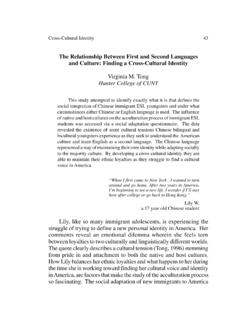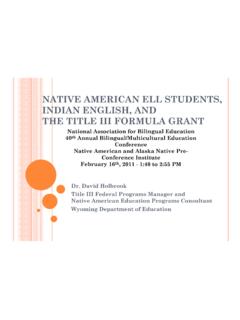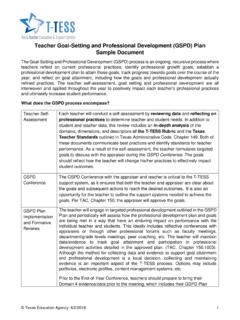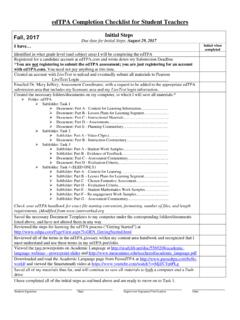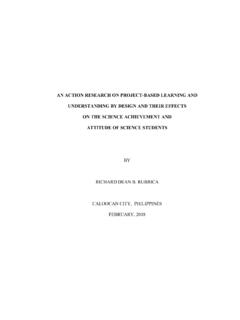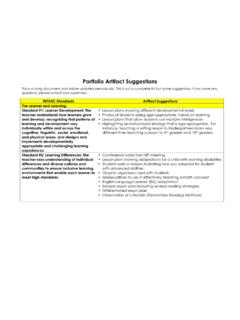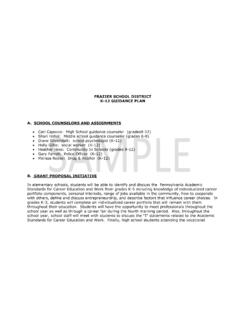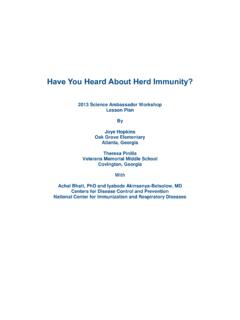Transcription of Chapter 2. Tools and Resources for Providing English ...
1 ES. Updated October 2017 U. IN PD SA. Chapter 2 CL A. UD TE. ED. Tools AND Resources FOR *. Providing English LEARNERS WITH A. LANGUAGE ASSISTANCE PROGRAM. This is the second Chapter of the English Learner Tool Kit, which is intended to help state and local education agencies (SEAs and LEAs) meet their obligations to English Learners (ELs). This tool kit should be read in conjunction with the Department of Education Office for Civil Rights' (OCR) and the Department of Justice's (DOJ) Dear Colleague Letter on English Learner Students and Limited English Proficient Parents, published in January 2015, which outlines SEAs' and LEAs'. legal obligations to ELs under civil rights laws and other federal requirements. The Dear Colleague Letter can be found at Providing English LEARNERS WITH A.
2 LANGUAGE ASSISTANCE PROGRAM. KEY POINTS. EL services and programs must be educationally sound in theory and effective in practice. EL programs must be designed to enable ELs to attain both English proficiency and parity of participation in the standard instructional program within a reasonable length of time. LEAs must offer EL services and programs, until ELs are proficient in English and can participate meaningfully in educational programs without EL support. Additionally, LEAs must provide appropriate special education services to ELs with disabilities who are found to be eligible for special education and related services. After ELs have been identified using a valid and reliable LEAs have the flexibility to choose the EL services and English language proficiency (ELP) assessment, LEAs programs that meet civil rights requirements and best must provide ELs with appropriate language assistance meet the needs of their EL population.
3 Appropriate EL. services and programs, commonly known as EL services services and programs enable ELs to attain both English and programs. LEAs must also provide special education proficiency and parity of participation in the standard services to ELs who have been identified as children with instructional program within a reasonable amount of disabilities under the Individuals with Disabilities Education time. LEAs must offer appropriate EL services until ELs Act (IDEA) or as qualified students with disabilities under are proficient in English and can participate meaningfully Section 504 of the Rehabilitation Act of 1973 (Section 504). in educational programs without EL support. This includes Meeting the needs of ELs with disabilities will be continuing to provide EL services to ELs at the highest discussed in depth in Chapter 6 of the EL Tool Kit.
4 Levels of English proficiency until they have exited from EL services and programs. *This Chapter has been updated to reflect changes to the Elementary and Secondary Education Act (ESEA), as amended by the Every Student Succeeds Act of 2015 (ESSA). The Department of Education has released a non-regulatory guidance (NRG) about ELs and Title III of the ESEA that is available at The text of ESEA, as amended by ESSA, can be found at You can access Tools and Resources for Providing ELs with a Language Assistance Program at Tools AND Resources FOR Providing ELS WITH A LANGUAGE ASSISTANCE PROGRAM 1. Updated October 2017. To determine which EL services and programs are best programs that succeed within a reasonable period of time, suited for a student identified as an EL, LEAs must LEAs should monitor the progress of ELs and adjust EL.
5 Consider the student's (1) English proficiency level, services and programs to ensure that students are making (2) grade level, and (3) educational background, as well expected progress. as (4) language background for bilingual programs. Other child-centered factors that LEAs may consider include the student's native language literacy; acculturation into ESSA UPDATE. society; and age he or she entered the United States. LEAs must ensure that qualified teachers provide EL services While the ESEA, as amended by ESSA, does and it is important for school personnel to understand not give a definition of a long-term English and address these factors. learner, Section 3121(a)(6) mandates a report LEAs should apply the same standards that OCR and DOJ every two years of the number and percentage apply when evaluating whether their chosen EL services of ELs who have not yet attained English and programs meet civil rights requirements.
6 These language proficiency within five years. For standards, established in Casta eda v. Pickard, include more information, see Section I of the NRG ( a three-pronged test: First, is the program based on an Department of Education, Office of Elementary educational theory recognized as sound by some experts and Secondary Education, 2016, p. 38). in the field or considered a legitimate experimental strategy? Second, are the programs and practices (including Resources and personnel) reasonably calculated The following checklist is intended to assist with to implement this theory effectively? Third, does the Providing appropriate EL services and programs. The program succeed in producing results indicating that checklist provides suggested questions only.
7 LEAs should students' language barriers are being overcome within a check their SEA's policies and federal guidance to ensure reasonable period of time? compliance. Some common EL programs considered educationally On which educational theory are the EL services and sound in theory under the first prong include: (1) English program options based? as a Second Language (ESL) or English Language Development (ELD); (2) Structured English Immersion What are the Resources needed to effectively (SEI); (3) Transitional Bilingual Education (TBE) or Early- implement the chosen program? Exit Bilingual Education; and (4) Dual Language or Two- Way Immersion. The first two programs are usually taught Does the school have qualified staff to implement the in English , and the latter two are taught both in English chosen program?
8 And in the EL's primary language. How are placement in a particular EL program and the provision of EL services informed by a student's Additionally, for new arrivals and students with English proficiency level, grade level, and educational interrupted formal education (SIFE), LEAs may establish and language backgrounds? newcomer programs. These programs offer specialized services and classes to help these students acclimate to Are EL services and programs provided to all eligible schools, develop foundational skills in content areas ELs, regardless of scheduling conflicts, grade, ( , basic literacy and math concepts), and prepare them disability, or native language? for the program options above. Newcomer programs are short-term, typically lasting no longer than one year.
9 Does the chosen EL program include instruction aligned to the state ELP standards and grade-level Finally, there is increased focus on the large number of content standards? ELs who, despite many years in US schools, are still not proficient in English . These students are often referred Do the EL services and programs provide ELs in to as Long Term English Learners (LTELs). To ensure that all grades with equal opportunities to participate meaningfully and equally in all of the schools'. LEAs have selected and implemented EL services and curricular and extracurricular programs? You can access Tools and Resources for Providing ELs with a Language Assistance Program at 2 Tools AND Resources FOR Providing ELS WITH A LANGUAGE ASSISTANCE PROGRAM. Updated October 2017.
10 Are EL services and programs designed to provide What criteria is the LEA using to evaluate its more intensive instruction for ELs who are the least program and determine if it is meeting its goals? proficient in English ? For example: Are ELs at the highest levels of ELP continuing to a. Are there processes and criteria in place to receive EL services until they have exited from EL. monitor ELs in and across programs in both services and programs? academic content and ELP? Are there additional EL services and programs b. Is there a process for modifying or replacing the available for ELs who have not made expected EL program if data shows that students are not progress despite extended enrollment in the EL making expected progress within a reasonable program ( LTELs)?

